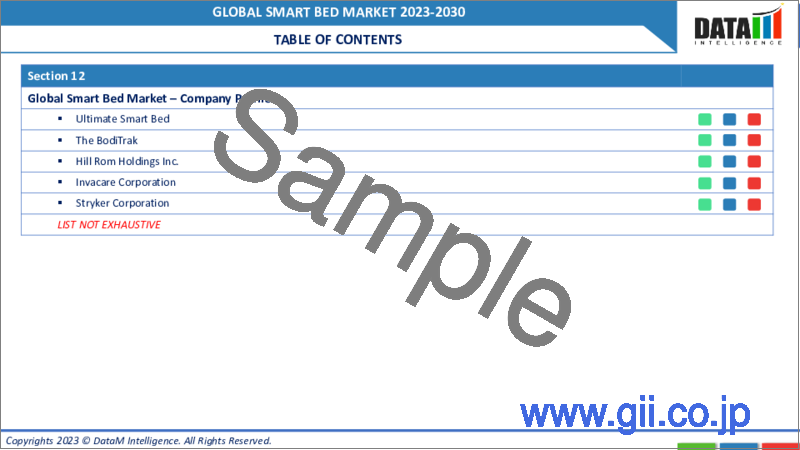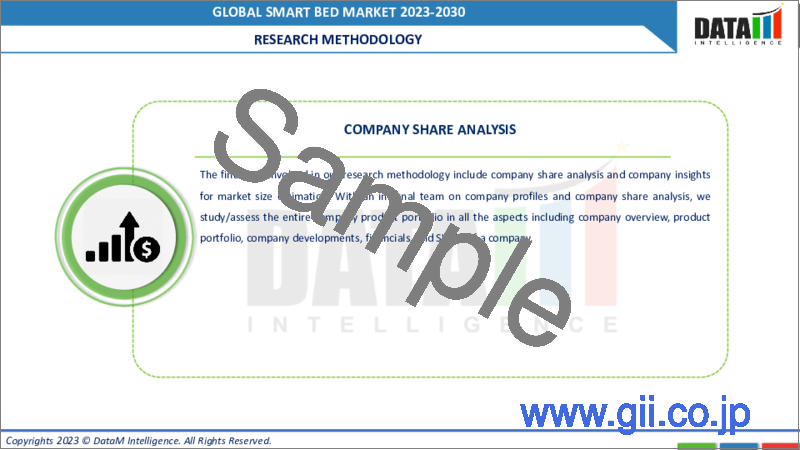|
|
市場調査レポート
商品コード
1217552
スマートベッドの世界市場-2022-2029Global Smart Bed Market - 2022-2029 |
||||||
|
● お客様のご希望に応じて、既存データの加工や未掲載情報(例:国別セグメント)の追加などの対応が可能です。 詳細はお問い合わせください。 |
|||||||
| スマートベッドの世界市場-2022-2029 |
|
出版日: 2023年02月14日
発行: DataM Intelligence
ページ情報: 英文 170 Pages
納期: 約2営業日
|
- 全表示
- 概要
- 目次
市場力学
スマートホーム技術への支出増がスマートベッド市場を牽引
技術の発展により、消費者はライフスタイルを後押しする新しい方法を模索するようになっています。それは、最新技術やスマートソリューションの採用に対する消費者の関心を高め、消費者に多くの利益をもたらしています。スマートホームエコシステムの構築に対する消費者の関心の高まりは、スマートベッドを含むスマートホームアクセサリーの消費要件を煽り、住宅空間における製品需要の促進が期待されています。Xiaomi Corporationによると、2020年3月のパンデミック以降、70%の人が生活環境を変え始め、約50%の人がパンデミック中に少なくとも1つのスマートホームデバイスを購入しているとのことです。スマートホーム製品の世界の需要を高める上で、世帯を超えたスマートテクノロジー機器の導入に対する消費者の嗜好が重要な役割を担っています。ドイツ消費者研究協会によると、ドイツ、英国、フランス、イタリア、スペイン、オランダ、ベルギーなどの欧州市場全体で、2020年にスマート製品の売上が前年比24%の急増を示しました。また、ヘルスケアや高級ホテルなどのホスピタリティ分野では、クラス最高のカスタマーサービス施設を提供するためにスマートベッドの要件が高まっており、製品需要を押し上げています。環境システム研究所が管理する商用ソフトウェア「ArcGIS」によると、2020年9月までに米国の病院全体でスマート機能を備えた有人ベッドの要件は約81万6554件に上ります。また、主要プレイヤーは新製品を投入しており、これが市場成長の原動力となることが予想されます。例えば、2022年8月24日、Xiaomiはスマート電動ベッドを発売しました。8H Feel Leather Smart Electric Bed X Proは、背中と脚にデュアルモーターを搭載しています。モーターは、最大600kgの重さを楽に持ち上げることができます。モーターは、最大動作音が45dB以下と静音性を実現しています。
目次
第1章 調査手法と範囲
- 調査手法
- 市場の範囲
第2章 主な動向と発展
第3章 エグゼクティブサマリー
- タイプ別市場内訳
- アプリケーション別市場内訳
- 流通チャネル別市場内訳
- 地域別市場内訳
第4章 市場力学
- 市場影響要因
- 促進要因
- 抑制要因
- ビジネスチャンス
- 影響分析
第5章 産業分析
- ポーターのファイブフォース分析
- サプライチェーン分析
- 特許分析
- 規制分析
第6章 COVID-19の分析
- COVID-19の市場に関する分析
- COVID-19以前の市場シナリオ
- COVID-19の現在の市場シナリオ
- COVID-19の後、または将来のシナリオ
- COVID-19の中での価格ダイナミクス
- 需要-供給スペクトラム
- パンデミック時の市場に関連する政府の取り組み
- メーカーの戦略的取り組み
第7章 タイプ別
- 手動式
- セミオートマチック
- 全自動
第8章 アプリケーション別
- 住宅分野
- ヘルスケア
- 病院
第9章 流通チャネル別
- オンライン
- オフライン
第10章 地域別
- 北米
- 米国
- カナダ
- メキシコ
- 南米
- ブラジル
- アルゼンチン
- その他の南米地域
- 欧州
- ドイツ
- 英国
- フランス
- スペイン
- イタリア
- その他の欧州地域
- アジア太平洋地域
- 中国
- インド
- 日本
- オーストラリア
- その他アジア太平洋地域
- 中東・アフリカ地域
第11章 競合情勢
- 競合シナリオ
- 競合の戦略分析
- 市況/シェア分析
- M&A(合併・買収)分析
第12章 企業プロファイル
- PARAMOUNT BED CO., LTD.
- 企業概要
- タイプ別ポートフォリオと説明
- 主なハイライト
- 財務概要
- ReST
- Sleep Number Corporation
- Ascion, LLC.
- Hi-Interiors srl.
- Ultimate Smart Bed
- The BodiTrak
- Hill Rom Holdings Inc.
- Invacare Corporation
- Stryker Corporation
第13章 DataM
Market Overview
Smart beds are technologically advanced beds that allow users to expand their capabilities beyond their basic functionalities by automatically adjusting the settings of the beds to the users' comfort. Smart beds improve the user's comfort while also providing health benefits. Smart beds integrate advanced amenities with technology, allowing for comfortable changes and connectivity while sleeping. Sleep tracking, automatic mattress firmness adjustment, climate control, smart fabric technology, adjustable bases, anti-snoring feature, IoT, and smart home connectivity are just a few of the features accessible. Furthermore, these beds will also keep track of blood pressure, heartbeats, movements, air pressure, and snoring.
The smart bed market is in its early stages of mass production, with sales growing slowly. Incidences of sleep disorders among adults are on the rise, attracting much attention to the concept of quality sleep, and, as a result, smart beds have much potential. Moreover, with technological advancement, the increase in sensor-based advanced technology for healthy sleep is driving the demand for the global smart bed market. The rising penetration of smart homes with technologically integrated household products will propel market growth.
The global smart bed market was valued at USD YY million in 2021. It is forecasted to reach USD YY million by 2029, growing at a CAGR of 7.12% during the forecast period (2022-2029).
Market Dynamics: Increased spending for smart home technology is driving the smart bed market
Technological developments have inspired consumers to seek new ways to boost their lifestyles. It has driven the consumer's interest in adopting the latest technologies and smart solutions, providing many benefits to the consumers. Increased consumer interest in creating a smart home ecosystem has fueled the consumption requirement for smart home accessories, including smart beds, which is expected to drive product demand among residential spaces. According to Xiaomi Corporation, since the pandemic in March 2020, 70% of people have started changing their living environment, and almost 50% have purchased at least one smart home device during the pandemic. Consumer preferences toward adopting smart technology devices across households have played a key role in enhancing the global demand for smart home products. According to the German Society for Consumer Research, the sales of smart products witnessed a spike of 24 percent in 2020 compared to the previous year across European markets, including Germany, the U.K., France, Italy, Spain, the Netherlands, and Belgium. Furthermore, an upsurge in the smart bed requirements from the hospitality sector, including healthcare and luxury hotels, to provide best-in-class customer service facilities has boosted product demand. According to ArcGIS, a commercial software maintained by the Environmental Systems Research Institute, there were around 816,554 staffed bed requirements with smart features across the hospitals in the U.S. through September 2020. Key players are also launching new products, which is expected to drive the market growth. For instance, on August 24, 2022, Xiaomi launched its smart electric bed. The 8H Feel Leather Smart Electric Bed X Pro is equipped with dual motors on the back and legs. The motors can lift weights of up to 600 kg with ease. The motors offer silent operation, with a maximum operating sound of less than 45 dB.
Market Segmentation: The hospital segment held the largest market share in the global smart bed market
The hospital segment is expected to lead a dominant segmental share in the global market due to increasing comfort facilities and provisions in the hospital. Also, improvements in healthcare technology have facilitated the medical sector's investment in opportunities for better healthcare, which has led to skyrocketing demand for advanced products across smart hospitals. The medical beds embedded with smart features have become essential for monitoring patients and undergoing treatments, thereby boosting the growth aspects of the global market. Smart beds in hospitals are expected to experience rapid growth globally, as these beds can detect any critical signs in patients, assisting healthcare workers in providing a rapid response to the patient's health. It has increased the adoption of smart beds in hospital systems. For instance, on October 22, 2020, Stryker announced that it launched the ProCuity wireless smart hospital bed to improve efficiency and safety while lowering costs. The intelligent bed was designed to help reduce in-hospital patient falls at all acuity levels while improving nurse workflow efficiencies and safety at a lower cost. On August 24, 2022, Indian medical device maker Dozee launched a smart connected bed with Midmark India. The smart bed can be connected to a central command center and a hospital's HMIS. Dozee claims its AI-powered RPM sensor has a clinical-grade accuracy of 98.4%.
Geographical Penetration: North America is the dominant region during the forecast period
The North American market size reached USD YY million in 2021. It is anticipated that North America will exhibit a dominant market share due to smart homes rapid penetration and increased consumer spending on comfort and luxury. According to the 10th annual Houzz & Home survey among 70,000 U.S. people, home renovation activities, including kitchens, outdoor spaces, and other home furnishings and technologies, have witnessed a 15% increase of over USD 85,000 in 2020, compared with USD 80,000 in the two previous years. The region's high-income population favors a wide range of smart solutions for their convenience and ease of lifestyle at home. It has led users to spend on automation, security, and other controlled accessories, ultimately attracting investments in such products. Additionally, the region has established a prominent base in IoT across residential and commercial places. Around 49,000 family homes in the U.S. had smart home features in their home construction out of 1.08 million single-family home constructions in the United States in 2020, as per the data by Omdia, a London-based consultancy firm.
Competitive Landscape:
The global smart bed industry is highly fragmented, owing to emerging local and international players in the global marketplace. Manufacturers focusing on introducing product innovations in features and options, creating growth opportunities worldwide, and implementing user-friendly customer service and policies to gain a long-lasting customer relationships with buyers. Some key players operating in the global smart bed market include PARAMOUNT BED CO., LTD., ReST, Sleep Number Corporation, Ascion, LLC, Hi-Interiors, srl., Ultimate Smart Bed, The BodiTrak, Hill Rom Holdings, Inc., Invacare Corporation, and Stryker Corporation. To meet increasing consumer demand, the key players/manufacturers create new campaigns and ads to uplift customer interest in buying products. For instance, in January 2021, Corsicana Mattress Co. partnered with Retail Service Systems (RSS) to introduce Sleep2Win smart beds to customize sleep patterns. In September 2021, Baxter International Inc., an American multinational healthcare company, acquired Hill-Rom Holdings, Inc., for a total equity value of $10.5 billion. This acquisition by Baxter adds smart hospital beds to its existing patient monitoring and diagnostic product portfolio. Hill-Rom Holdings, Inc. is a medical device provider based in the USA.
COVID-19 Impact: Positive impact on the global smart bed market
Due to the pandemic, many homeowners spent more time at home than ever before, which led to several pain concerns for them. Many people developed new ways to work, unwind, occupy themselves, and make their bed as a personal space as well as a workstation at home as a result of being isolated. With more people preferring to spend their time indoors, a shift in purchase behavior is observed, exhibiting an interest in online channels. Increased product sales through online platforms helped the market growth positively. Furthermore, the lockdown restrictions shifted consumer behavior towards well-being, personal care, and comfort at indoor places, fueling the demand for smart home accessories, including smart beds. For instance, in August 2020, Hi Interiors Srl introduced a four-poster bed connected with intriguing features such as HiAm to promote fun and well-being in the bedroom. The HiAm bed has a 70-inch screen, an audio system, ambient reading lights, and a 4K projector for entertainment while you're in bed.
The global smart bed market report would provide access to approximately 58 market data tables, 55 figures and 170 pages.
Table of Contents
1. Scope and Methodology
- 1.1. Research Methodology
- 1.2. Scope of the Market
2. Key Trends and Developments
3. Executive Summary
- 3.1. Market Snippet by Type
- 3.2. Market Snippet by Application
- 3.3. Market Snippet by Distribution Channel
- 3.4. Market Snippet by Region
4. Market Dynamics
- 4.1. Market impacting factors
- 4.1.1. Drivers
- 4.1.2. Restraints
- 4.1.3. Opportunities
- 4.2. Impact analysis
5. Industry Analysis
- 5.1. Porter's five forces analysis
- 5.2. Supply Chain Analysis
- 5.3. Patent Analysis
- 5.4. Regulatory Analysis
6. COVID-19 Analysis
- 6.1. Analysis of Covid-19 on the Market
- 6.1.1. Before COVID-19 Market Scenario
- 6.1.2. Present COVID-19 Market Scenario
- 6.1.3. After COVID-19 or Future Scenario
- 6.2. Pricing Dynamics Amid Covid-19
- 6.3. Demand-Supply Spectrum
- 6.4. Government Initiatives Related to the Market During the Pandemic
- 6.5. Manufacturers Strategic Initiatives
7. By Type
- 7.1. Introduction
- 7.1.1. Market size analysis, and y-o-y growth analysis (%), By Type Segment
- 7.1.2. Market attractiveness index, By Type Segment
- 7.2. Manual*
- 7.2.1. Introduction
- 7.2.2. Market Size Analysis, US$ Million, 2020-2029 And Y-O-Y Growth Analysis (%), 2021-2029
- 7.3. Semi-Automatic
- 7.4. Fully Automatic
8. By Application
- 8.1. Introduction
- 8.1.1. Market size analysis, and y-o-y growth analysis (%), By Application Segment
- 8.1.2. Market attractiveness index, By Application Segment
- 8.2. Residential*
- 8.2.1. Introduction
- 8.2.2. Market Size Analysis, US$ Million, 2020-2029 And Y-O-Y Growth Analysis (%), 2021-2029
- 8.3. Healthcare
- 8.4. Hospitality
9. By Distribution Channel
- 9.1. Introduction
- 9.1.1. Market size analysis, and y-o-y growth analysis (%), By Distribution Channel Segment
- 9.1.2. Market attractiveness index, By Distribution Channel Segment
- 9.2. Online*
- 9.2.1. Introduction
- 9.2.2. Market Size Analysis, US$ Million, 2020-2029 And Y-O-Y Growth Analysis (%), 2021-2029
- 9.3. Offline
10. By Region
- 10.1. Introduction
- 10.1.1. Market Size Analysis, And Y-O-Y Growth Analysis (%), By Region
- 10.1.2. Market Attractiveness Index, By Region
- 10.2. North America
- 10.2.1. Introduction
- 10.2.2. Key region-specific dynamics
- 10.2.3. Market Size Analysis, And Y-O-Y Growth Analysis (%), By Type
- 10.2.4. Market Size Analysis, And Y-O-Y Growth Analysis (%), By Application
- 10.2.5. Market Size Analysis, And Y-O-Y Growth Analysis (%), By Distribution Channel
- 10.2.6. Market Size Analysis, And Y-O-Y Growth Analysis (%), By Country
- 10.2.6.1. U.S.
- 10.2.6.2. Canada
- 10.2.6.3. Mexico
- 10.3. South America
- 10.3.1. Introduction
- 10.3.2. Key Region-Specific Dynamics
- 10.3.3. Market Size Analysis, And Y-O-Y Growth Analysis (%), By Type
- 10.3.4. Market Size Analysis, And Y-O-Y Growth Analysis (%), By Application
- 10.3.5. Market Size Analysis, And Y-O-Y Growth Analysis (%), By Distribution Channel
- 10.3.6. Market Size Analysis, And Y-O-Y Growth Analysis (%), By Country
- 10.3.6.1. Brazil
- 10.3.6.2. Argentina
- 10.3.6.3. Rest of South America
- 10.4. Europe
- 10.4.1. Introduction
- 10.4.2. Key Region-Specific Dynamics
- 10.4.3. Market Size Analysis, And Y-O-Y Growth Analysis (%), By Type
- 10.4.4. Market Size Analysis, And Y-O-Y Growth Analysis (%), By Application
- 10.4.5. Market Size Analysis, And Y-O-Y Growth Analysis (%), By Distribution Channel
- 10.4.6. Market Size Analysis, And Y-O-Y Growth Analysis (%), By Country
- 10.4.6.1. Germany
- 10.4.6.2. U.K.
- 10.4.6.3. France
- 10.4.6.4. Spain
- 10.4.6.5. Italy
- 10.4.6.6. Rest of Europe
- 10.5. Asia Pacific
- 10.5.1. Introduction
- 10.5.2. Key Region-Specific Dynamics
- 10.5.3. Market Size Analysis, And Y-O-Y Growth Analysis (%), By Type
- 10.5.4. Market Size Analysis, And Y-O-Y Growth Analysis (%), By Application
- 10.5.5. Market Size Analysis, And Y-O-Y Growth Analysis (%), By Distribution Channel
- 10.5.6. Market Size Analysis, And Y-O-Y Growth Analysis (%), By Country
- 10.5.6.1. China
- 10.5.6.2. India
- 10.5.6.3. Japan
- 10.5.6.4. Australia
- 10.5.6.5. Rest of Asia Pacific
- 10.6. Middle East and Africa
- 10.6.1. Introduction
- 10.6.2. Key Region-Specific Dynamics
- 10.6.3. Market Size Analysis, And Y-O-Y Growth Analysis (%), By Type
- 10.6.4. Market Size Analysis, And Y-O-Y Growth Analysis (%), By Application
- 10.6.5. Market Size Analysis, And Y-O-Y Growth Analysis (%), By Distribution Channel
11. Competitive Landscape
- 11.1. Competitive scenario
- 11.2. Competitor strategy analysis
- 11.3. Market positioning/share analysis
- 11.4. Mergers and acquisitions analysis
12. Company Profiles
- 12.1. PARAMOUNT BED CO., LTD.*
- 12.1.1. Company Overview
- 12.1.2. Type Portfolio and Description
- 12.1.3. Key Highlights
- 12.1.4. Financial Overview
- 12.2. ReST
- 12.3. Sleep Number Corporation
- 12.4. Ascion, LLC.
- 12.5. Hi-Interiors srl.
- 12.6. Ultimate Smart Bed
- 12.7. The BodiTrak
- 12.8. Hill Rom Holdings Inc.
- 12.9. Invacare Corporation
- 12.10. Stryker Corporation
13. DataM
- 13.1. Appendix
- 13.2. About us and services
- 13.3. Contact us




